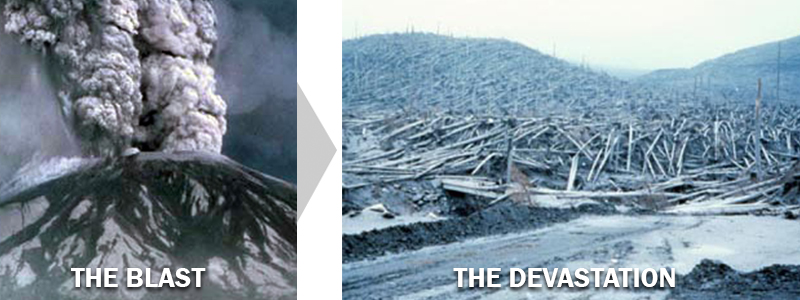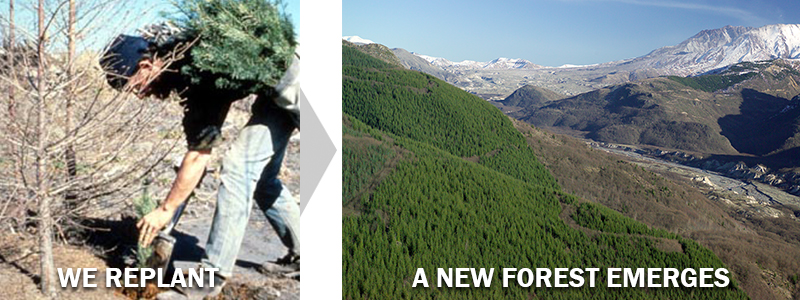 Forest Management
Forest Management
A working balance
A TALE OF TWO FORESTS
A working forest is a beautiful balance between people and nature. Picture dense fir forests near pristine lakes and streams. Living beside our workers who plant, tend, harvest and plant again are:
- Large and small mammals such as cougar, elk, deer, bear, chipmunk, squirrel, rabbit and raccoon
- Eagles, Steller's jays, woodpeckers, owls, wrens, sparrows and crows
- Salmon, trout and various other fish
- Reptiles, insects and amphibians such as newt, salamander and frog
- Tree species such as Douglas-fir, Pacific silver fir, noble fir, western hemlock and western red cedar
- Fern, salal, huckleberry and hundreds of other plants
Following the eruption, there were two choices:
- Let nature take its course.
- Provide assistance to jump-start the forest’s recovery.
In 1982, Congress let nature take its course and established the Mount St. Helens National Volcanic Monument. The U.S. Forest Service manages it today for research, recreation and interpretation.
Weyerhaeuser chose to assist our forests in their recovery.
Our company is invested in continually deepening our understanding of trees, soil, water and wildlife. We had the knowledge to help the forests around Mount St. Helens rebound, thanks to years of scientific research on natural forests and their cycles.


THE WEYERHAEUSER APPROACH
Salvage
Salvage and recovery plans began immediately. Much of the downed timber could be used, but if left untouched, the wood was at great risk of insect damage and disease. We needed to work quickly, but safely. After the government completed a study to assess the hazards of working in ash and determined what safety measures were required, we initiated a full-scale salvage effort.
- More than 1,000 people were involved in the salvage efforts.
- Up to 600 truckloads of downed logs were removed each day.
- Salvage work continued for nearly two years.
These efforts helped save 850 million board feet of timber, enough to build 85,000 three-bedroom homes.
Plant seedlings. Lots of them.
Workers began digging through deep ash in order to plant 18 million seedlings by hand. We needed those seedlings to take root. Fortunately, Weyerhaeuser began scientific research on how to effectively grow seedlings in the 1940s when we started the first certified tree farm in North America, and we leveraged those decades of learnings to help our forests around the volcano recover. Our typical planting procedure involves:
- Preparing the site by exposing mineral soil to aid seedling survival and growth
- Reducing soil erosion
- Using our high-quality seedlings
- Replanting quickly, within 12 months of harvest for almost every area
- Planting species in the right geographies and climates for them to thrive: western red cedar, grand fir and hemlock in select locations; Douglas-fir and red alder in lowlands; and noble fir at elevations above 2,800 feet
Nurture young trees
After we plant seedlings, we ensure their long-term survival by:
- Fertilizing — In the Northwest, we fertilize some trees a few times over their life cycle to help growth. Fertilizer is only applied on acres where it will improve the nutrients, and we use only approved fertilizers and carefully apply them away from lakes and streams.
- Thinning — By removing select trees from the forest when they are between 12 and 30 years old, we can help reduce competition for water, nutrients and sunlight and increase tree size.
Protect trees from harm
It might be impossible to protect forests from a volcanic eruption, but our methods help minimize risks from forest fires, insects, disease and animal damage. We protect all parts of the forest ecosystem, including:
- Wildlife — During harvest we leave snags, live trees and downed logs. It might look messy, but it provides food and cover for animals.
- Fish — We protect spawning beds and keep streams clean by carefully managing the design, construction, use and maintenance of our roads. We leave forested buffer zones to protect rivers, lakes, streams, springs and ponds where fish can spawn.
- Watersheds — We analyze entire watersheds to assess the combined effects of land use on fish habitat and water quality. This leads to land management plans that protect natural resources and municipal water sources.
- Landscapes — We combat fires with aerial surveys, quick-response teams, tanker trucks and helicopters, and we reduce landslide risk whenever possible through carefully managed harvest methods.
Harvest mature trees
On average, we harvest only 2 percent of our timberlands each year. This percentage ensures we have a sustainable harvest in perpetuity while meeting our economic objectives. In harvesting the forest, we use a variety of forest management techniques, including clearcutting — where most trees in an area are harvested at the same time, much like the effect of a forest fire or volcanic eruption. This method is effective for trees on the west side of the Cascade Mountain range, such as Douglas-fir, which does not tolerate shade from a forest canopy.
Forest harvests are all about engineering and planning. Long-term and short-term planning of a forest is a complex task, and our investment in new geographic information systems and satellite-based programs has improved planting, stand selection, harvest tracking and road maintenance, among other areas.
Replant again
As we do on all our lands, we replant soon after harvest to ensure another healthy forest will grow and thrive for future generations.
YOU MAY ALSO BE INTERESTED IN:
By using this website, you agree to our Privacy Policy. California residents: See our CCPA Privacy Notice for details on what personal information we collect and for what purposes.
